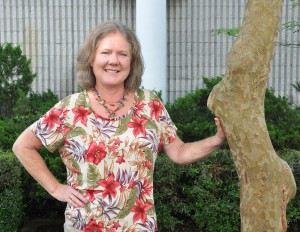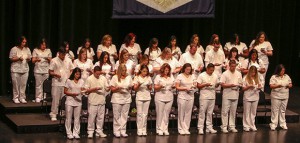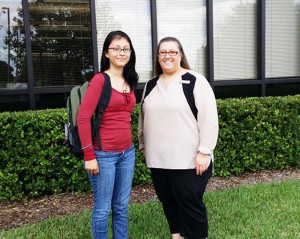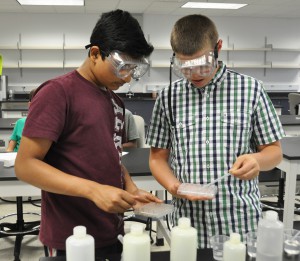AVON PARK, Fla. – June 30, 2016 – On a muggy day in late June, nearly 150 middle and high school students descended on Ona, Fla., a small town in western Hardee County.
Why Ona and not a theme park?
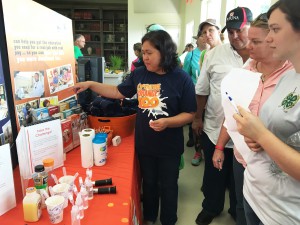
Dr. Mary-Grace Danao of SFSC’s Bioenergy program with visitors to her interactive teaching activity at the Youth Field Day.
Because Ona, with a population of 314 people and 1,200 cattle, played host to the ninth annual Youth Field Day, a daylong series of classes and educational activities intended to spark an interest in agriculture among young people.
To aid in that effort, South Florida State College was on hand to offer an interactive educational activity and to drum up interest among the students in SFSC’s agricultural program offerings.
The University of Florida’s Institute of Food and Agricultural Sciences put on the educational event at its Range Cattle Research and Education Center, a 2,480-acre extension facility in Ona.
During the day, the students rotated through classes on pasture management, microscopic bugs, and photographing wildlife.
One of the instructors opening students’ minds to the wonders of agriculture was Dr. Mary-Grace Danao, SFSC’s lead instructor in bioenergy education. She guided students on the use of a refractometer, showing them how to use the small, handheld device to gauge the sugar content of several juices.
In agricultural production, winemakers and brewers use refractometers to measure the sweetness of wine and beer.
“The event did an awesome job at exposing youth participants from across Florida to potential careers in agriculture,” said SFSC’s Summer Miller, college recruiter, who fielded questions from students on opportunities in agricultural programs at SFSC.
SFSC offers several programs in agriculture. Students can enroll in one of two Associate in Science degree programs: Citrus Production Technology or Landscape Horticulture Technology. Students interested in shorter courses of study can opt for college credit certificate programs in either the Landscape Horticulture Professional or Technician tracks.
Agriculture is big business the region that is home to SFSC. Together the three counties that comprise the SFSC service area–DeSoto, Hardee, and Highlands– produce about $690 million worth of agricultural products annually, according to the latest figures from the United States Department of Agriculture.
People often think of citrus production as the main driver of the region’s agricultural economy. While orange groves dominate the landscape astride many roads, cattle pastures account for a lot of unseen agricultural production. Two-thirds of Florida’s cattle pasture can be found in the southern half of the state.
Another sector of the agricultural economy is bioenergy production–turning agricultural products, like grasses, into fuels.
SFSC recruited Dr. Danao earlier this year to head up the college’s bioenergy program. The program offers associate degrees and college credit certificates in biofuel and biomass production and cultivation.
At the Ona event, Dr. Danao showed students how to work the refractometers, teaching them how to apply liquid to the sensor, peer into the measurement screen, and determine the “brix,” or sugar content, of different juices.
In the afternoon, students had time to discuss career opportunities with representatives from colleges who turned out for the event.
“It gave us an opportunity as well to showcase SFSC’s programs and degrees,” said SFSC’s Miller. “While at the same time offering a fun and educational agriculture activity.”
For more information, contact the SFSC Advising and Counseling Center at 863-784-7131.
AVON PARK, Fla. – June 27, 2016 – Dr. Kimberly Batty-Herbert, who has served as the dean for the Division of Arts and Sciences at South Florida State College since 2007, will leave her post on June 30.
When the new academic year starts this fall, Dr. Batty-Herbert will have already taken up the position of vice president for academic affairs at Cecil College, a community college in northeastern Maryland.
“This is a good time for me to move on to the last phase of my academic career,” Dr. Batty-Herbert said. “I am nearing retirement and the position at Cecil College will give me an opportunity to help another institution drive academic achievement for its students.”
Dr. Batty-Herbert came to SFSC from Broward College, where she served as the associate dean for academic affairs and taught classes in communication. At SFSC, Dr. Batty-Herbert never left the classroom behind. In addition to overseeing the associate in arts degree program, she taught the required speech class at SFSC.
Earlier in her academic career, Dr. Batty-Herbert had taught at a community college in New Mexico. It was in New Mexico where the Pennsylvania native completed her undergraduate and graduate degrees.
Dr. Batty-Herbert said she takes great satisfaction in the work she accomplished helping SFSC grow its dual enrollment program. “I enjoyed working with the adult students in our college credit program,” Dr. Batty-Herbert said. “It was especially rewarding working with the high school students participating in our dual enrollment program—it’s great to see them get so much out of their experience here on campus.”
Helping younger students prepare for college is a passion for Dr. Batty-Herbert. During her tenure she ushered in a regular series of summer enrichment programs–often called bridge programs– that prepare high school juniors and seniors for the rigors of college coursework.
“Bringing high schools students on to SFSC’s campus during the summer, putting them through the paces, and giving them a feel for college life is critical to their success,” Dr. Batty-Herbert said. “You can’t wait until they show up after high school graduation. You’ve got reach them before that.”
She also oversaw the development of SFSC’s second bachelor’s degree program, the Bachelor of Science in Elementary Education (BSEE).
“We graduated our inaugural class of elementary school teachers this May, with many of them already hired on with local school districts,” Dr. Batty-Herbert said. “Now we’re tweaking the BSEE class schedule to give working folks the opportunity to enter the program without altering their day schedule.”
As she prepares for her final day at SFSC, Batty-Herbert has made several house hunting trips to towns around Cecil College. “I looked at an amazing 1930s bungalow with a view of the Chesapeake Bay,” Dr. Batty-Herbert said. “But my husband won’t join me until the spring of 2017, so I may hold off on buying until he arrives.”
Cecil College lies in a corner of Maryland where the borders of Pennsylvania and Delaware meet. Dr. Batty-Herbert said she has many option to choose from before settling on buying a house.
Dr. Batty-Herbert will by no means sever her ties with Highlands County. “I am coming back,” she said. “We own a great house on Lake Sebring, with a dock, and a tiki hut my husband built where we want to live out our retirement.”
Her son, a deputy sheriff with Highlands County, will watch over the house while Dr. Batty-Herbert is away.
Lynn MacNeill, a long-serving professor of communication, will take over Dr. Batty-Herbert’s duties for the next academic year, giving SFSC an opportunity to mount a search of a new dean.
During the final week of the spring term, Dr. Batty-Herbert learned the students had voted her adjunct professor of the year. “I was just so tickled by their recognition,” Dr. Batty-Herbert said. “What a nice send-off.”
She noted she feels a kinship with many of the students at SFSC, particularly the dually-enrolled high school students. “I, too, was a dual enrollment student at a community college,” Dr. Batty-Herbert said. “I know how important a good start to college is for success because I was once one of them.”
AVON PARK, Fla. – June 23, 2016 – How did an artist who discovered a love for nature in the cool air of the High Sierra settle in flat, hot, humid Florida, and come to love her new home?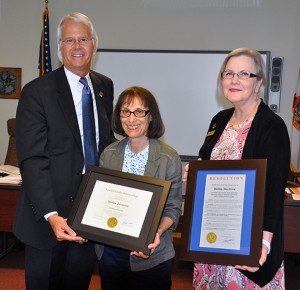
The answers lies in the story of how Mollie Doctrow came to be a landscape artist and curator of the Museum of Florida Art and Culture (MOFAC) at South Florida State College (SFSC).
Doctrow, who has served as MOFAC’s curator for 11 years, will retire at month’s end to tend to her love: capturing Florida’s landscapes in her art. A love that has its beginnings in a trip to the mountains.
“I was 16 years old when I first went to the High Sierra as camp counselor,” Doctrow said. “I remember saying to myself ‘Holy cow this is nature,’” as she recalled the camping trip that included a week backpacking along the John Muir Trail.
Doctrow described her experience in the northern California mountains as a moment akin to an epiphany, saying she was never the same again.
The two weeks in the mountains were not Doctrow’s first exposure to beauty. “My family moved to France for a year when I was in the ninth grade,” said Doctrow, who grew up in the uninspiring sprawl she called “greater Los Angeles.”
“We lived in Bois-le-Roi, a farming village outside Paris, where I was captivated by the splendor of the rural charm.”
Doctrow recalled how she marveled at the simplicity of village life that left her parents befuddled. “My mother was used to supermarkets, not the open air markets of the village,” Doctrow explained. “So she would send me shopping for the meat, and I loved it—so much so that I wanted my family to leave me there.”
It was a year later that Doctrow would visit the High Sierra, saying that she felt half alive until then. “Both experiences—France and the mountains— are still vivid in my mind. I was never the same after that,” she said.
Doctrow’s love of the outdoors had not yet found an expression in art. She enrolled at the University of California at Northridge to study philosophy. “I went to college overwhelmed by questions like ‘What is goodness?’” Doctrow said. “It took me four years to find out nobody had the answer.”
While Doctrow concentrated on the meaning of goodness, she dabbled in art by taking drawing classes as she worked toward her bachelor’s degree. “I didn’t see a path ahead for me as an artist,” she said. “I didn’t even know what an art career was at the time.”
After graduation from Northridge, Doctrow returned to Europe for nearly a year. Her second trip abroad jolted her into rethinking her career path. “When I came back home, I went to Santa Monica City College, which is a community college, to study printmaking and drawing,” she said.
“I lived in the printmaking studio,” said Doctrow, describing how she took to her new passion. “I started making and selling my prints, and couldn’t stop.”
After a year at Santa Monica, Doctrow returned to Northridge to enroll in its master’s degree program in printmaking. “They told me they would accept me on the condition that I not do flowers,” Doctrow said. “I agreed, finished the program, and went right back to doing flowers, landscapes, and realisms of nature.”
Next came freelance work in computer graphics and a string of adjunct teaching positions. Doctrow landed her first full-time teaching job at Brevard College, located in a mountainous region of western North Carolina, where she taught art and computer graphics for 10 years.
Toward the end of her time at Brevard, Doctrow drove to central Florida to visit a friend who owned a ranch. “By that time, I was well into doing prints of natural habitats but had not experienced the landscapes of southern Florida,” Doctrow said. “I took a trip to the Everglades, and my eyes popped out because I had never seen anything like that before.”
Doctrow was hooked. She immediately sought out an opportunity to return and scored a summer residency through the national parks. After an intense period of drawing landscapes and rendering them to prints, Doctrow went hunting for place to exhibit them.
An Internet search turned up a venue: the Museum of Florida Art and Culture at SFSC. Doctrow called the curator, Jim Fitch, and the two hit it off immediately.
“I visited the SFSC Highlands Campus to meet Jim at MOFAC,” Doctrow said. “I found a museum with empty shelves but I also found a man who loved art and was eager to show my work.”
Fitch invited Doctrow back for a semester of teaching, which Doctrow immediately accepted. “Then Jim retired, and I seized the opportunity to come on full time.”
SFSC offered the curator post to Doctrow. “I would never have expected I would live in place without mountains, an area as flat, hot, and humid as Florida,” Doctrow said. “But I’ve come love this area of Florida, and MOFAC and SFSC, all of which have come to mean so much to me.”
During Doctrow’s tenure at MOFAC, the museum collection expanded and its stature as a regional venue of Florida art and culture grew. Doctrow earned a reputation for mounting cutting-edge exhibitions of major Florida artists.
“Without a doubt, Mollie’s curatorial expertise put MOFAC on the map of top-notch museums in Florida,” said Cindy Garren, director of Cultural Program at SFSC. “Mollie’s tenure at SFSC has raised the bar when it comes to judging the quality of an exhibition at a regional museum in the state.”
Doctrow not only cared for MOFAC’s collection, she taught graphics classes to SFSC’s students. Collaborating with Cathy Futral, a professor in the art department, Doctrow mounted a series of exhibitions showcasing the work of SFSC’s alumni, many of who have gone on to rewarding careers in the arts.
“Mollie has made a tremendous impression on the artistic abilities and creativity of SFSC’s students,” Garren said. “Our alumni have moved on to exciting careers in the arts but return for regular alumni exhibitions, serving as an inspiration for our current students.”
Doctrow’s ardor for nature found an outlet on the SFSC Highlands Campus. In 2011, she oversaw the opening of the Wildflower Wayside Shrine Trail, a quarter-mile, self-guided walking trail that honors the endangered plant species found on the Lake Wales Ridge, the oldest ecosystem in the southeastern United States. On the trail, the public can glimpse native plants: the pygmy fringe tree, the big flag pawpaw, sky-blue lupine, and St. John’s Wort.
Well before her retirement at the end of June, Doctrow will have already completed the line-up for MOFAC 2016-17 exhibition season. “Our first exhibition on Oct. 5 will open the season with works by former faculty, regional artists, and SFSC alumni,” Doctrow said. “It will be a great evening to introduce MOFAC’s new curator, Megan Stepe, to the museum’s family.”
What words of advice does Doctrow have for Stepe? “MOFAC is awesome!” Doctrow said, thrusting her arms in the air. “What’s more, Megan will find a supportive community that includes the college administration, its trustees, the faculty, our students, the dedicated volunteers, and an amazing number of residents who are committed to Florida history, culture, archeology, and art.”
Doctrow’s retirement plans call for her to stay put in Highlands County. “People keep asking me what I am going to do after SFSC,” Doctrow said. “I tell them ‘art.’ I am going to do art full time, like a job. I’ll wake up, go to my studio and put in a day’s work, then do other things.”
Through her 11 years at MOFAC, Doctrow continued to exhibit her work in venues across the state and abroad. Some of her recent work will go on display this month at an exhibition mounted by Arts on Douglas, a New Smyrna Beach gallery.
“My love for art comes from my passion for nature,” Doctrow said. “It’s not about the art, it’s about the experience. That’s what making art is for me. That’s what MOFAC has been about, the experience of a community coming together to install art shows, programs, and enjoy the art, history, and sharing.”
AVON PARK, Fla. – June 21, 2016 – Malware that harms computers. Breaches in personal data that’s transmitted and stored over the internet. Hacking that shuts down websites, takes over social media accounts, and steals vital business records and financial information. As these threats evolve and change, so do the practices that combat them, which is why cybersecurity has become one of the fastest-growing careers in the computer industry.
On Saturday, July 16, South Florida State College will conduct a one-day class on the cybersecurity practices that protect against common risks that come from using the internet. “Introduction to Cybersecurity” covers the global implications of cyber threats, how computer networks become vulnerable to attack, and the impact of cyber-attacks on business. It will explain Cisco Systems’ approach to detecting and defending computer networks against cyber-threats and explain opportunities for pursing professional certifications in cybersecurity.
The class runs from 8 a.m. to 5 p.m. in Building I, Room 210, on the SFSC Highlands Campus. Cost is $69 per person with a maximum class size of 24 students. To register, call 453-6661, 773-3081, 993-1757, or 465-3003 and request Course Registration Number (CRN) 30911.
As part of its commitment to training highly skilled I.T. workers in Florida’s heartland, SFSC also offers one-year college credit certificate programs in network security, which includes a focus on cybersecurity, and digital forensics, which teaches students how to recover trace material in digital devices often relating to criminal activity and how to find the source behind breaches in network security. College credits earned in these programs can be applied to SFSC’s associate in science (AS) degree in Network Systems Technology. For more information about these courses, call SFSC’s XCEL-IT program at 784-7439.
AVON PARK, Fla. – June 20, 2016 – Thirty-two graduates of South Florida State College’s Associate Degree Nursing (ADN) program were honored in a traditional pinning ceremony on Thursday evening in the Wildstein Center for the Performing Arts at SFSC, Highlands Campus, Avon Park.
The graduates are Melissa Acosta, Jimmy Bunn, Bianca Cannon, Carmen Corona Zavala, Cheryl Cox, Courtney Crosby, Christian Cruz, Kyle Daniels, Megan Davidson, Alyssa Diaz, Daniel Duque, Elizabeth Etherton, Anallely Guzman, Mckenna Hellein, Erika Hernandez, Margie Herndon, William “Tadd” Holton, James Aaron Houser, Megan Hughes, Perla Mendieta-Arvizu, Laura Nieto, Maribel Perez-Badillo, I. Natalia Ramos, Taylor Ritacco, Jacqueline Rivera, Michelle “Mika” Rivera, Ana Rodriquez, Liliana Sanchez, Stephanie Smith, Mary Stacy, Chiquita Stewart, and Erica Tovar.
Guest speaker, Dr. Michele Heston, director of Nursing Education at SFSC, began her presentation by recounting the Seven C’s of Caring at SFSC, a model of competencies for nursing program graduates.
They are competence, compassion, confidence, conscience, commitment, communication, and culture.
Dr. Heston explained that when she spoke with students about them during their final nursing practicum, students wove the seven C’s throughout their own stories of caring for patients. She said, “It is in capturing such moments and turning them into stories that we shape who we become. Storytelling lifts facts from text books and drops them into our lives in powerful ways.”
Dr. Heston told her own story of how a nurse cared for her when she was hospitalized as a premature infant. “It is because of a practical nurse named Polly that I am standing here tonight!”
“I implore each of you to never doubt the influence you will have in other people’s lives,” Dr. Heston said to the graduates. “That will help your nursing heart grow and expand and provide rich stories to illustrate your careers and lives. You already have stories that define you as nurses.”
“Someone, somewhere, will breathe a little easier because you were there. Each of you will heal wounds, bring lives into this world, and help usher lives out of the world. Never doubt how vitally important that work is, and look for the gifts within each day.”
During the ceremony, graduates accepted their nursing pins from a person of their choice, in most cases a relative or friend who they credited with being supportive throughout their lives.
Dr. Heston said that “The highlight of completing a program of study in nursing is receiving the nursing pin, and that it is a symbol of service that includes many professional rights and responsibilities.”The practice of pinning new graduates has been a nursing school tradition in the United States since 1916. The pin is worn prominently on a nurse’s uniform throughout her or his career. One story of the ceremony’s beginning goes back to 1883, when Queen Victoria awarded Florence Nightingale the Royal Red Cross on St. George’s Day for her service to the sick and injured during the Crimean War. In turn, Nightingale later extended the honor to her outstanding nursing students by presenting them with a medal of excellence.
Each year, ADN graduates award the Golden Duck to someone who has served as a mentor to the students in the program. The D.U.C.K. acronym represents the foundational elements of the mentoring arrangement: Developing, Understanding, Compassion, and Knowledge.
During the ceremony, ADN graduate Cheryl Cox presented the 2016 Golden Duck Award to Laurie Simmons, an SFSC nursing instructor. “She is an outstanding leader, exemplifying the high standards that this program demands,” Cox said. “We say that she instills confidence that lets us know we can and will accomplish anything we set our minds to. She brings all that she is and has been as a nurse and says ‘let me show you the way.’ We’ll never forget the way you’ve loved us with your care and dedication.”
Graduates of the ADN program become registered nurses by passing the National Council Licensure Examination for Registered Nurses (NCLEX) exam. SFSC nursing graduates are usually fully employed in nursing within a few months of graduation.
SFSC’s ADN program is the only nationally accredited nursing program in its service district of Highlands, Hardee, and DeSoto counties. It is accredited through the Accreditation Commission for Education in Nursing, Inc. (ACEN).
SFSC offers ADN program options for students interested in becoming registered nurses: a two-year Generic-RN program and a one-year Transition-LPN to RN program. The college also offers a one-year practical nursing occupational certificate program. For program entry requirements, consult the SFSC College Catalog on the website or call 863-784-7027.
AVON PARK, Fla. –June 15, 2016 –Laura Wilder has been with South Florida State College, literally, from the ground up.
In 2001, Wilder was working toward her associate degree at SFSC’s campus in DeSoto County. At that time, located in the Fountain Plaza shopping center in the center of Arcadia, the campus was a mere three classrooms, one office, and a small room that housed the library.
“A part-time opportunity opened to work as evening staff assistant,” said Wilder. “SFSC offered me the job and I said ‘yes,’ thinking it would be a good way make ends meet while I was taking classes.”
Now, 15 years later, Wilder has worked her way to student advisor and watched SFSC build out a campus that houses ample classrooms, computer labs, a library, and her own office. Along the way, she has earned accolades from her supervisor and the students she serves.
At a time when job hopping is becoming the norm, Wilder’s longevity with SFSC harkens to a day when workers spent their entire careers with one employer. Today, younger employees work fewer than three years with an employer, according the data from the Bureau of Labor Statistics.
Wilder first came to SFSC’s storefront campus 17 years after graduating from high school. She had hit a rough patch in her life. “I needed a new direction. I visited the campus at Fountain Plaza and met Effie Keen, the campus director, who helped get me get started on my educational journey,” Wilder recounted.
“I was taking classes while working part time at the campus,” Wilder said. “So I witnessed the construction of the new campus in 2003 and even took my last classes there.”
“After Fountain Plaza, the new campus was another world,” Wilder said. “We went from no space to a campus that could absorb increased enrollment, more classes at different times, and new programs. And I got to experience it not only as a student, but as an employee, and member of the community.”
Wilder completed her associate degree shortly after SFSC opened the new campus. She soon was brought on as a full-time staff assistant. “Being a student with SFSC launched my career working in higher education. It’s been an absolute blessing for me.”
The new campus wasn’t just a boon for Wilder, the residents of DeSoto County were ecstatic, according to Wilder.
“The reaction was one of shock and awe, but in a positive way,” Wilder said. “The community was thankful for the opportunity for more classes that were convenient. Also, SFSC could offer more programs.”
Working full time and caring for a family didn’t stop Wilder from eyeing career advancement. She completed her bachelor’s degree in business at Warner University in Polk County.
“Finishing my bachelor’s degree opened a path for me to move up the ladder at SFSC,” Wilder said. “My bachelor-level coursework gave me the skills to work one-on-one with students, helping them chart their educational choice.”
Wilder said her experience as a new student, one who walked into SFSC not knowing where to start, gives her insight into helping the people, young and not so young, who visit the SFSC DeSoto Campus looking to jump-start a career.
“A good part of what I do involves talking to folks new to SFSC,” Wilder said, explaining her typical day. “Prospective students come in, and I’ll ask them to sit down so that we can talk about educational opportunities that will lead to a career they will find rewarding.”
Suzanne Demers, the DeSoto Campus director, heaps praise on Wilder’s work with the students. “The students love her,” Demers said, summing up Wilder’s performance.
Advising new students centers on developing a degree outline detailing what classes they have to take to attain a degree or college-level occupational certificate. Her work with students also includes guiding students through the maze of the financial aid application process, including the scholarships available to them from the SFSC Foundation.
“One aspect of my role is to ensure students get plugged into SFSC’s established support network,” Wilder said, referring to the college’s array of student support services that offer personalized guidance designed to keep students focused on program completion.
“In short, I suppose one can say I help students lay the foundation to attain their long-term goals,” Wilder said. “It’s wonderful talking to new people from all walks of life and see how excited they become once they know a future awaits them at SFSC.”
Wilder is the only student advisor assigned to the SFSC DeSoto Campus. When she’s not on deck ready to help a student, Demers will step in to fill the void.
“Laura is a true asset to the college,” said Demers. “She has a way with students that makes them feel at ease, which in turn allows her to guide the student through their college and life goals.”
Wilder said she never forgets the hurdles she ran up against before she got her start at SFSC. “I feel a tremendous sense of accomplishment when I help someone get on the right path,” Wilder said. “I know what folks are going through because I’ve been there myself.”
When Wilder is not meeting with her students in Arcadia, she’s traveling to visit her three grandchildren. “I’ve have two granddaughters— ages 5 and 4— and grandson whose first birthday is in July,” Wilder said with noticeable glee. “My husband and I travel to Bradenton and Panama City to cram in as much time as we can to be with the little one.”
Wilder also devotes time to assisting local charitable organizations, especially the annual Relay For Life.
“I overwhelming credit SFSC for giving me the opportunity not only to start as a student, but as an employee— they set the tone that put me where I am at today” Wilder said. “SFSC turned my life around.”
AVON PARK, Fla. – June 14, 2016 – Season subscriptions are now available for the upcoming performance season at the Wildstein Center for the Performing Arts at South Florida State College (SFSC). Subscriptions are available for the Matinee, Artist, and Jazz series performances.
“In addition to saving up to 20 percent, subscribers get the best seat for the entire season, pay less in processing fees, don’t have to wait in line, get a 10 percent dining discount at the Hotel Jacaranda, and receive special subscriber discounts for select performances,” said Cindy Garren, director of Cultural Programs at SFSC. “Subscribers also receive invitations to Meet the Artist receptions.”
The Artist Series lineup includes the worldwide piano sensation Ethan Bortnick, Nov. 19; family holiday favorite “Miracle on 34th Street,” Dec. 1; a nostalgic evening of doo wop with the Bronx Wanderers, Jan. 12; the Florida Orchestra, Jan. 19; a tribute to Motown titled “So Good for the Soul,” Jan. 28; country stars Pam Tillis and Lorrie Morgan, Feb. 8; “Presley, Perkins, Cash and Lewis: A Night To Remember”, March 2; bestselling contemporary Christian artists Point of Grace, March 9; Women Of Ireland, March 23; and one of the world’s top vocal groups, Human Nature, April 1.
All Artist Series performances are held in the 1,460-seat Wildstein Center for the Performing Arts at SFSC and begin at 7 p.m. Subscriptions range from $258 to $325.
The popular Goodtime Tuesdays Matinee Series includes the Flying Horse Big Band, Jan. 10; David Osborne Trio, Jan. 17; “You’ll Never Walk Alone” with Brian Gurl, Jan. 24; the Agatha Christie who-done-it “Murder On The Nile,” Jan. 31; “The Martin and Lewis Tribute Show,” a tribute to Dean Martin and Jerry Lewis, Feb. 7; Music of the 1960s “What’s Up, Pussycat?,” Feb. 14; the “Shake, Rattle & Laugh” variety show, Feb. 21; music from the ‘50s and ‘60s with Pauly and The Good Fellas, Feb. 28; and Neil Zirconia, a tribute to Neil Diamond, March 7.
All Matinee performances are held in the Wildstein Center for the Performing Arts and begin 1:30 p.m. Subscriptions range from $145 to $190.
The Jazz Series lineup includes the Eddie Metz Trio with Nicki Parrott and Rossano Sportiello, Jan. 18; one of today’s hottest trumpeters Bria Skonberg, Jan. 26; Bill Allred’s Classic Jazz Band, Feb. 9; swing band New Orleans Nighthawks, Feb. 18; and the Canamger Band, March 8.
All Jazz Series performances are held in the 250-seat SFSC University Center Auditorium and begin at 7 p.m. Subscription packages range from $107 to $116.
The Wildstein Center for the Performing Arts and the SFSC University Center Auditorium are located on the SFSC Highlands Campus, 600 W. College Dr., Avon Park. Free parking is available.
All areas of the Wildstein Center for the Performing Arts and the SFSC University Center Auditorium are accessible to persons with disabilities.
Subscriptions can be purchased online at www.sfscarts.org or call the Box Office at 863-784-7177 for a mail order form. For further information, email culturalperformances@southflorida.edu.
AVON PARK, Fla. – June 13, 2016 – A friend tells you she works in supply chain management. Someone else says he’s employed in logistics. Sounds interesting, but what do they do?
If you have ordered a book or electronic device from Amazon.com and go online regularly to check its status, then you know what logistics and supply chain management is about.
From buying the in-demand products and keeping the right amount in stock, to picking items off the warehouse shelves and packaging them, to transporting them to your doorstep, roughly 6 million Americans earn their living working in supply chain management, or, more broadly, logistics.
Those jobs are in demand in South Florida State College’s service area and the college has a program in place to meet the need.
“The logistic industry is important to Florida, which is home to many distribution centers,” said Tina Gottus, who heads up SFSC’s series of Xcel-IT programs. “With the growth in global trade, the expansion of the Panama Canal, and the increasing capacity of Florida’s ports, we’ll surely see rising employment in the logistics sector.”
“Supply chain management is not just telling a forklift driver in a warehouse what to do,” Gottus said. “The field includes purchasing, transportation management, packaging, warehousing—the entire scope of logistics.”
Gottus said the number of jobs in logistics is poised to grow 22 percent during the next decade. That growth is happening in Florida’s Heartland. Amazon recently opened a distribution center in Polk County that employs nearly 500 people.
Closer to home, CitraPac, the maker of frozen fruit snacks, will open a plant at the Sebring Airport and Commerce Park this summer. The company plans to hire nearly 250 employees, with some of those positions requiring skilled logistics managers.
“SFSC has forged a partnership with CitraPac,” Gottus said. “They’re already hired some of our program participants.”
Gottus said students can complete SFSC’s logistics program within a year. She noted students can start the six-course program in any academic term. The college is accepting applications now for Fall Term 2016.
CitraPac is one of many companies that are tenants of Sebring’s airport. The two-runway airport bills itself as a multimodal transportation facility and commerce park. “For example, five of our major tenants receive most of their raw materials by a rail link at the airport,” said Mike Willingham, executive director of the Sebring Airport Authority. “The finished products are then shipped out by truck-that’s multimodal.”
Willingham said he talks to logistics companies frequently about locating at the airport, which is 8 miles from downtown Sebring. “One statistic I always tell companies is the airport is within 150 miles of 85 percent of Florida’s population,” he said. “Even though most distribution centers are sited near major population centers, we’re still strategically located and ripe for expansion.”
Jobs in logistics are not confined to distribution centers and manufacturing plants. One of the first graduates of SFSC’s logistics program, Becky Tyson, is now a purchasing manager for the Highlands County Sheriff’s Office. Purchasing managers ensure enough materials and supplies are on hand to keep operations running smoothly.
“The program is really great—it will open your eyes to the many avenues under the logistics umbrella,” said Tyson. “You may think logistics only has to do with transportation or shipping, but there’s so much more to it.”
Tyson said the coursework helped her improve her management of inventory. “I learned the significance of holding costs and how that effects our budget. I implemented changes in my department based on the information I learned,” she said.
The six-course program Tyson completed includes: introduction to supply chain management, warehouse management, transportation and distribution, purchasing and inventory management, principles of quality management, and operations management.
“Our graduates this year are taking the Certified Logistics Technician examination,” Gottus explained. “This credential demonstrates they have the skills to function in a mid-level logistics position, not at merely at an entry level.”
For students interested in a program leading to a degree, SFSC offers an Associate in Science degree in supply chain management.
SFSC’s logistics program is growing, with more than 15 students now enrolled. Those students can look forward to an expanding logistics industry.
At the urging of Gov. Rick Scott, the Legislature appropriated about $850 million over the last five years for upgrades to Florida’s ports to handle growth in the transportation of raw materials and finished goods.
With the upcoming completion of a major expansion of the Panama Canal, Gottus said Florida is ready to take advantage of growing trade from overseas.
Trade and logistics already support about 1.5 million jobs in Florida.
“With its logistics program, SFSC is cultivating the future to help leaders like the airport’s Willingham attract logistics-related business to our area,” Gottus said. “Local leaders can now say ‘look what our college is doing— SFSC is producing the talent to fill these future new jobs.’”
For more information about SFSC’s 24-month Associate in Science degree in supply chain management or its one-year logistics and transportation specialist college credit certificate, call 863-784-7439 or email xcel-it@southflorida.edu.
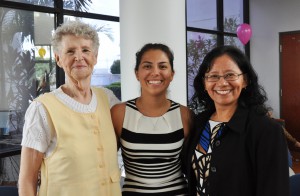
From left: Caroline Coley, Genesis Castillo, and Irene Castanon together before the start of the recognition ceremony.
AVON PARK, Fla.–June 8, 2016–Family, friends, and mentors with Take Stock in Children (TSIC) came together on June 7 for an evening of celebration and recognition at South Florida State College.
They filled the seats of the SFSC University Center Auditorium on the SFSC Highlands Campus to honor the accomplishments of 23 TSIC mentees who had just graduated from high schools in DeSoto, Hardee, and Highlands counties.
“This is that wonderful evening each year when we come together for our mentor appreciation and mentee recognition ceremony,” said Jamie Bateman, executive director for Institutional Advancement at SFSC, who also heads up the SFSC Foundation. The SFSC Foundation serves as the lead agency for TSIC within the college’s service district of DeSoto, Hardee, and Highlands counties.
“Before I talk about our students’ accomplishments, it’s only fitting to say ‘thank you’ to our mentors,” Bateman said. “They have given so much of their time to help shape these students into the young ladies and men we see here tonight.”
The 23 graduates had completed the journey to high school completion with the help of their TSIC mentors. TSIC matches students at-risk of not completing high school with mentors who guide them toward earning their diplomas, with college scholarships awaiting those who graduate and enroll in college.
Bateman illustrated the students’ achievements. “The average grade point average for the 23 graduates was 4.71,” she said. “One student graduated with a 5.4052—I had to get that number two in there,” she said to the laughter of the audience.
“One of our graduates just finished high school and simultaneously earned her associate degree from SFSC and another earned an occupational certificate,” Bateman said.
Collectively, the students earned $228,627 in college scholarships, Bateman said. She added they had already earned 360 hours of college credit toward their undergraduate degrees by participating in the dual enrollment program at SFSC.
TSIC mentors typically meet with their assigned students each week during the school year, offering encouragement, advice, and a sympathetic ear. A TSIC college success coach provides support and guidance to the mentor and the mentee.
Bateman then called each graduate up to the stage. One by one, they mounted the stage and introduced themselves to the audience, mentioning their mentor’s name, what college they would attend, and what they would study.
From nursing to medicine to psychology, the students spoke of their dream careers, with most saying they would complete their first two years of college at SFSC.
“We have a bunch of bright grads here tonight,” Bateman said after the parade of graduates had left the stage.
Bateman called two students back to join their mentors on stage. She asked each pair to speak about their relationship and what it meant to them.
Caroline Coley, a 92-year-old retiree from New York, joined her mentee, Genesis Castillo, at the microphone. Turning to Castillo, Coley said, “This young lady is so bright she did not need my help with her schoolwork. What she needed was someone outside her usual circle who would listen.”
Castillo graduated at the top of her class at Avon Park High School. She has completed enough college credits as a dual enrolled student at SFSC to enable her to complete her associate degree in one year.
Mentor Karen Creamer gave her mentee, DeQualon Fudge, a hug after wiping away the tears she shed in recalling their years together since meeting in the seventh grade. “I have been honored to serve as this young man’s mentor on his journey to adulthood,” Creamer said.
Fudge will enroll in Florida Gulf Coast University this fall where he plans to major in accounting.
Before the evening event could come to an end, Bateman noted there was an item on the agenda that bore no name. She asked Wally Cox, who will close out his 16 years as Highlands County Superintendent of School, to come to the stage. Bateman handed him a framed photograph with an inscription thanking him for his service to TSIC.
The audience rose to their feet, whistling and applauding Cox as he accepted the photograph.
“What a wonderful evening we have each year when we recognize the mentors and mentees,” said Irene Castanon, coordinator for the local TSIC program. “What makes it so special is watching the mentors and mentees come together for one final meeting before the grads start the next chapter in their lives.”
AVON PARK, Fla.–June 8, 2016–Robert Worthington, a prominent and wealthy resident of the community, was murdered in his kitchen while cutting red cabbage. Police find a knife with a strange green stain on the handle had been thrust in his chest.
When detectives arrive, they encounter a slew of suspects. Was it Worthington’s cook, who was preparing a vinegar salad; his maid, who used ammonia to clean the tiles; or his nephew, who had just returned from swimming in the salt water of the ocean?
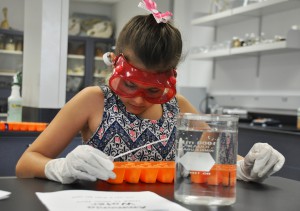
A student tests ammonia against red cabbage juice in an attempt to solve a murder during SFSC’s STEMQuest classes.
The detectives turn to chemists to help sort out a telling clue: the green stain on the knife’s handle.
Those chemists were fourth and fifth graders from schools in South Florida State College’s three-county service area. They were huddled in a laboratory on SFSC’s Highlands Campus running a gamut of tests to determine which suspect left the mysterious green stain.
Worthington is a fictional character, but the scenario and tests were real. The students were participating in SFSC’s summer STEMQuest classes.
SFSC’s STEMQuest program is a series of half- and full-day classes to introduce schoolchildren to science, technology, engineering, and mathematics, popularly known as STEM. SFSC faculty fashion the classes to handle the subjects in a fun and engaging manner.
“Watching the students delve into the experiments and lab work demonstrates that kids love science and technology,” said Dr. Kimberly Batty-Herbert, SFSC’s dean of arts and sciences. Dr. Batty-Herbert oversees the program that runs several times throughout the year.
Leslie Comeaux, a STEM coach at Sun ‘n Lake Elementary School, led the students through a series of chemical tests to determine which suspect caused the green stain to appear on the knife.
Dipping pipettes into several different acid solutions, the students sought to identify what type of chemical might have turned the cabbage juice on the knife green and, in doing so, discover who murdered Worthington.
“Wow, that ammonia really smells awful,” one of the goggle-clad students said, as she tested red cabbage juice against the chemical the maid was using to clean the tiles.
Comeaux gave each student instruction on how to run the tests and ensure personal safety. All the time, she kept reminding them, “If you find out who killed Worthington, keep it to yourself. Don’t blurt out the answer to the murder.”
Across the hall, seventh, eighth, and ninth graders were learning about experimental design. Cedric Bullard, a chemistry teacher at Avon Park High School, walked students through a sample experiment: How many drops of water can a penny hold?
Students bent over their work stations with droppers of various sizes. Each gingerly placing drops of water on pennies. Then the counting started, with the students coming up with wildly varying totals.
“You see, it’s important to design an experiment in a scientific manner to come up with valid results,” Bullard told the students. “The size of the dropper, which side of the penny you use, and how far away you hold the dropper will affect the outcome of the experiment.”
Next, the students moved on to real chemistry. Bullard designed an experiment involving acids and bases intended to teach the students how to differentiate between the two chemicals while learning more about the importance of experimental design.
While no murder was involved, Bullard’s students took up the challenge, teaming up in threes to replicate his instructions and produce valid results.
The students ran tests using a conductivity meter to see which bases and acids best served as a conductor of electricity. The students learned about ions and how their presence in the solutions affect the strength with which electricity is conducted.
Back across the hall, at least one student’s test solved Worthington’s murder. “Quiet, now,” Comeaux told the student. “We don’t want anyone but the detectives to know.”
Hearing that command, the other students scurried about from lab station to lab station trying to catch up and solve the murder as well.
“Offering the STEMQuest classes is not only rewarding for the students,” said Dr. Batty-Herbert. “It gives us at SFSC a sense of satisfaction that we are opening up young minds to the wonders of science.”
For more information on SFSC’s STEMQuest programs, contact the SFSC Arts and Sciences office at 863-784-7329.

